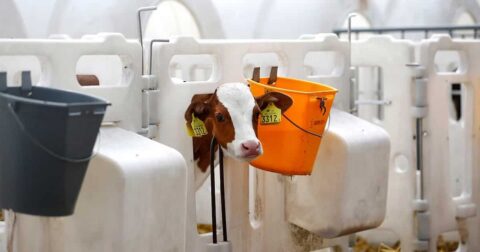News
Could Genetically Engineered Fungus Help Replace Animal Protein?
Breakthroughs•5 min read
Perspective
Speciesism is more than just an animal rights issue. The Deputy Leader of the UK's Animal Welfare Party, Jane Smith, explains why our understanding of social justice must evolve to include animals.


Words by Jane Smith
As the UK’s first-ever elected animal rights councilor, I long ago lost count of the times I’ve been in local government settings arguing that our real communities are multi-species, multi-component living collectives that include people, other animals, insects, trees, soil organisms, streams and so on. As an elected representative for Animal Welfare Party, the only UK political party that’s committed to ending speciesism, I certainly see it as my job to ensure any of our council decisions take into account the needs of all those individuals and living entities in the wider community.
Is speciesism a social justice issue? The answer must be unequivocally yes. But to deconstruct the idea of social justice while applying an animal rights lens, we need to look at our understanding of society and justice, both separately and together.
So many see society as people only, that is, our human society, with its human culture. But this constitutes a narrow, excluding, and speciesist view. We could—and I do—apply the same measure to the idea of real communities.
This, of course, necessitates small steps. I started in March 2019 with a council motion stipulating wildlife tunnels as mandatory in every new wall or solid fence in our town. I called it the “hedgehogs motion” because I felt other councilors, whose votes I needed for the motion to pass, wouldn’t want to be seen to deny survival chances to much-loved hedgehogs. But in fact, I was thinking about a whole range of wildlife, including toads, frogs, mice, reptiles, and many more. The wildlife tunnels stipulation has proved a highly popular move, with dozens of other UK councils having now contacted me wanting to do the same thing. In truth, it’s become what I always meant it to be—a starting point for bringing humans round to the idea of multi-species communities that co-exist in a given space, a land, a world.
From this inexpensive and very simple policy, which was easy to portray as a win-win for people and wildlife, other steps I’ve taken since then have included introducing policies around more controversial issues. Last year, I managed to make us the first UK town council with a humane-only (non-lethal) rodent control policy. Here, my focus had to be on human waste being the problem, not rats or mice, and that human problems require human—and humane—solutions. It’s an example of something councils should have been doing for decades already, given the rapid decline in hedgehog and other wildlife populations, but it takes a specifically non-speciesist worldview to make the initial change, which then proves popular with the public at large and hopefully becomes mainstream.
Justice, meanwhile, is a much more abstract concept and therefore worryingly prone to differing takes as to what it is or isn’t. But most people would understand justice as meaning “fair treatment,” with some sort of equitable aspect thrown in.
So if I’m thinking about social justice, as an animal rights advocate I’m personally thinking about a wider, greater inter-species society where all are treated fairly. The “fairly” part, though, would hinge for most people around enshrined rights—and therein lies the problem, because other animals’ rights, and trees’ rights, and water rights, and land rights, are in no way enshrined or upheld in our human societies (yet).
In an ideal world, everyone and everything’s rights would be recognized and respected, and infringements of those rights would be prohibited and punished accordingly where they did take place. But although this probably makes total sense to most people in theory, in practice the respecting of others’ rights, including other animals’ rights, would impinge quite significantly on most people’s current way of life. It would mean not being able to build roads through woods, for example, as well as not deliberately taking animals’ lives for food or fur.
It becomes obvious here that awareness of the rights of wild and farmed animals, in particular, requires a willingness to reconsider, and then to radically change, current human behaviors. But it is straightforward enough for us as animal rights advocate to argue that the plundering of the seas, the burning of the forests, and the servitude of billions of animals captive in factory farms worldwide are all behaviors of rampant human capitalism, colonialism, and speciesism.
That gap between the ideal world and the actual world is the space where I work and where we as the animal rights movement need to focus. We’re idealists, after all, and our job is to bring the actual world closer to our ideal of how it should be.
Simply put, in an ideal world there would just be “rights.” Not human rights, animal rights, land rights, and so on—just rights, universally understood, legally enshrined, and culturally upheld.
As animal advocates, we can see a much better world—and our job is to share that vision with others so that they can not only see it too but also want it to happen. If we can effectively communicate our vision and bring people with us, we’ll create a tipping point whereby most humans are prepared to take the necessary steps, both individually, as consumers, advocates, and influencers and collectively, as governments, NGOs, and corporations, to bring that new world into being.
Speciesism is very much a social justice issue, and now is the time to really start tackling it.